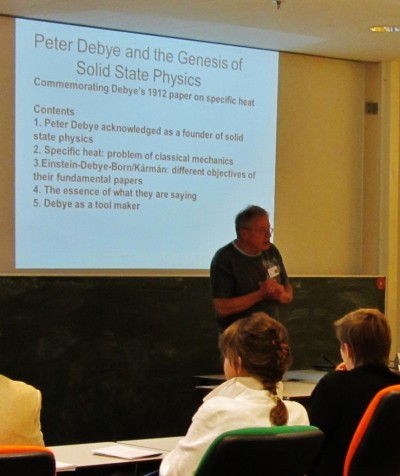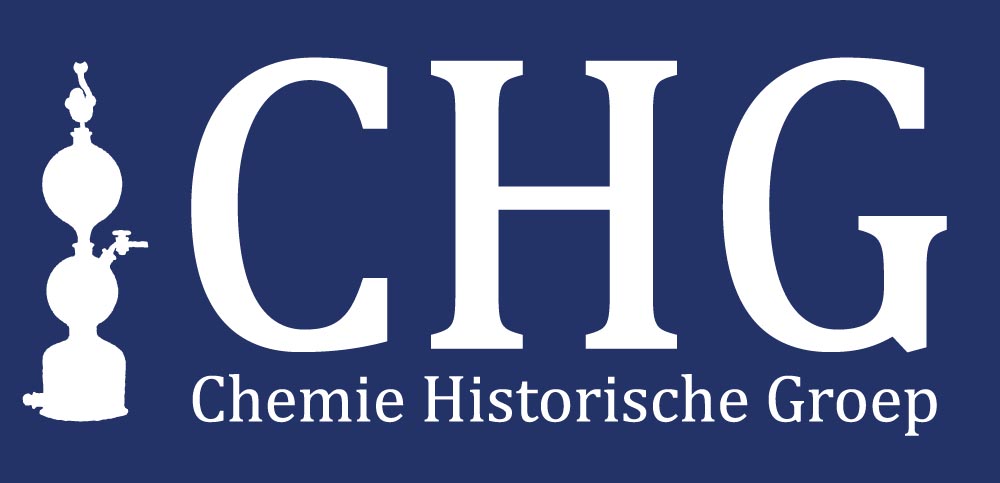History of Solid-state Physics and Chemistry
Op de KNCV voorjaarsbijeenkomst – georganiseerd samen met de NNV – gehouden op woensdag 30 mei in Enschede (Universiteit Twente) – was de CHG vertegenwoordigd met een “focus sessie”, getiteld: History of Solid-state Physics and Chemistry, met de focus op de 20e eeuw, en op de rol van Nederlandse wetenschappers. De belangstelling viel een weinig tegen (ongeveer 20 toehoorders, onder hen wel een drietal studenten). De lezingen waren zeer de moeite waard:
(1) Peter Debye and the Genesis of Solid State Physics: Commemorating Debye’s 1912 paper on specific heat [Jurrie Reiding | Nieuwegein],
(2) X-Ray Investigation of the Solid State: the Work of Jo Bijvoet en Willy Burgers [Ernst Homburg | UMaastricht],
(3) E.W. Gorter; his Contributions to Structural Chemistry in Relation to Physical Properties [Jacob van Dijk & Kees Plug | CHG],
(4) The Transmission Electron Microscope: Its Early Development and Recent Achievements [Stan Konings | FEI].
Saillant detail is nog dat de ook aanwezige dochter van E.W. Gorter opmerkte dat Gorter zelf haar nooit zo goed had kunnen uitleggen wat hij nu precies deed als de twee sprekers (3) van die middag – waarvan acte!
Hieronder wordt de inleiding tot het programma en de samenvattingen van de lezingen (in het Engels) weergegeven. In drie gevallen vergezeld van de sheets van de gehouden presentaties.
Introduction to Session
In consultation with its corresponding section of the NNV, the Chemistry History Group (CHG) has organised this session on Solid State Chemistry and Physics in the 20th Century, where the emphasis is on the role of Dutch scientists. As it will appear from the various abstracts, 2012 is a good year to have such a session. The first of the four presentations will focus on Peter Debye, and it is something of a first in another sense, as the speaker, Jurrie Reiding, will give us the fruit of his work in the Maastricht Debye-archive, on Debye’s American period, which has led to the reconstruction of Debye’s important role in the rise of lattice dynamics (think Debye-temperature), a subject usually associated with Max Born. Among Debye’s many other interests was also an early one in X-Ray diffraction (cf., the Debye-Scherrer method), a then new method which P. Ehrenfest considered of great importance especially for chemists, and this forms the bridge to the second presentation, on the work of the Dutch crystallographers J.M. Bijvoet and W.G. Burgers. The fame of the former rests largely on his development of a method for the determination of the absolute configuration of molecules, while the latter is well-known for his insights into the formation and structure of dislocations. The determination of structures is one thing, predicting them is another one, and establishing relations between structure & physical properties a third one. Evert W. Gorter spent his career pursuing the last two, first in Philips (magnetic materials, like Ferroxdur), and then at Leiden University – and note: this presentation has been put together by two of Gorter’s former graduate students. Gorter’s successor at Leiden, B.G. Hyde, was an avid user of electron microscopy to look at defect oxides (a.o. Magnéli phases), which leads into the final presentation, on the history of this technique. The role of Le Poole (Delft) will be highlighted, Burgers will make a brief reappearance, and the power of the various instruments will be illustrated with examples from material science.
Convener: Rob van Veen, together with Patricia Kooyman & Ernst Homburg.
Abstracts
Peter Debye and the Genesis of Solid State Physics – Commemorating Debye’s 1912 paper on specific heat
Jurrie Reiding
In 1963 Peter Debye, then already 79 years old, had been invited to attend the International Conference on Lattice Dynamics, held at the university of Copenhagen on August 5-9. This conference missed by only one year the fiftieth anniversary of the publication in 1912 of ‘those papers by Born and von Kármán and by Debye which are acknowledged to provide the starting point for the modern study of lattice dynamics’, as the foreword to the proceedings of the conference stated. Debye gave in Copenhagen a historical introduction to the subject: The Early Days of Lattice Dynamics.
In 1967 Armin Hermann published the eighth physics volume of the Documents of Science Einstein—Debye—Born—Kármán: Die Quantentheorie der spezifischen Wärme. Hermann included, besides his introduction and reprints from the papers from Debye and Born/Kármán, also Einstein’s 1907 paper, which resolved, by use of Planck’s quantum hypothesis, one of the main problems of classical physics of the 19th century: the diminishing specific heats of solids by lowering temperature. Einstein’s message was twofold: he almost definitively settled the on-going dispute concerning the quantum hypothesis in favour of Planck, and, second, henceforward it should be impossible to develop lattice dynamics and solid state physics negating the quantum.
With this we have emphasized Debye’s role as a forerunner in solid state physics and also as an early adherent of quantum mechanics. This paper aims at presenting the first stage of lattice dynamics, stressing the history of Debye’s effort, and the contents of his 1912 paper with the still highly commended ‘Debye Temperature’ and ‘T3-law’.
After 1912 Debye abandoned the specific heat problem, but not solid state physics. In 1914, very soon after the discovery of X-ray diffraction, he published a famous paper containing the computation of a factor which expresses the intensity decrease of the individual diffraction spots as a function of temperature, wavelength and diffraction angle.

X-Ray investigation of the Solid State – The work of Jo Bijvoet and Willy Burgers
Ernst Homburg
2012 obviously is a year of commemorations. Hundred years ago, not only Evert Gorter was born, and Peter Debye wrote his key paper on the specific heat of solids, but also Max Laue invented X-ray diffraction as a technique to study crystal lattices. Soon after, important results were obtained in the UK by William and Lawrence Bragg, father and son.
In the Netherlands, the physicists were among the first to acknowledge the importance of the new invention: Herman Haga, together with the physical chemist Frans Jaeger, at Groningen, Antoon Lorentz and Willem Keesom at Leyden, and Peter Debye at Utrecht, followed by Keesom, who had moved to Utrecht, and his assistant Nicolaas Kolkmeijer.
The pioneering physicists were soon succeeded by two chemists, who can be considered as thefounding fathers of experimental X-ray diffraction in the Netherlands, Jo Bijvoet (1892-1980), a student of Kolkmeijer, and Willy Burgers (1897-1988), a student of Lorentz at Leyden, and Jaeger at Groningen.
Bijvoet and Burgers followed quite contrasting career trajectories, and developed the field of X-ray diffraction in rather different directions. Bijvoet, son of a paint manufacturer, a ‘capitalist’, or at least an entrepreneur, embarked on a life-long career in academia. His early research on X-ray diffraction focused on inorganic salts, he went to Lawrence Bragg in Manchester, the center of inorganic X-ray crystallography, in 1926, but later gained his greatest successes in the investigation of organic single crystals, culminating in the absolute configuration of optically active compounds by means of X-rays in 1951.
Burgers, by contrast, came from a (lower) middle class background, with pronounced socialist sympathies, and worked in an industrial laboratory for several years, before he became a professor, almost simultaneously with Bijvoet (1939/40). His early research was on optically active organic substances, working with William Bragg from 1924-1927. But after he had entered the Philips Physics Laboratory in 1927 the rest of his career would be devoted to the investigation of complex multi-crystallite inorganic materials, especially metals, using Debye-Scherrer X-ray experiments, electron microscopy (already in 1935), and other techniques.
We will conclude with some speculations on the relations between the contrasting scientific approaches of Bijvoet (homogeneous and theoretical) and Burgers (heterogeneous and imaginitive), and their different social backgrounds and careers.
Use the following link for the slide presentation.
E.W. Gorter – His Contributions To Structural Chemistry In Relation To Physical Properties
Jacob van Dijk and Kees Plug
This year we commemorate that prof. E.W. Gorter was born 100 years ago. In 1964 he became professor of inorganic chemistry at Leiden University, as the successor of prof. A.E. van Arkel. He flourished in this setting, but he also faced serious health problems, which resulted in his too early death at 59.
After Gorter completed his studies in inorganic chemistry with Van Arkel, he moved to the UK to become a Ramsey fellow as a start to a scientific career. The war, however, strongly interfered with this, and he joined the Princess Irene brigade doing war-related work in London, under the leadership of prof. J.H. de Boer. After the war he moved to Philips Eindhoven (Nat Lab), where he played a pivotal role in the understanding of the structures & magnetic properties of ferri-magnetic oxides. Philips commercialised cubic-spinel derived compounds under the brand-name of Ferroxcube as well as some specific hexagonal ferrites under the brand-name Ferroxdur.
In the presentation it will be endeavoured to highlight some of the special contributions E.W. Gorter made during his career. It will also be tried to place him in the context of a scientific tradition in Leiden. The authors, Jacob van Dijk and Kees Plug, took a university degree under his direction, and indeed are happy to have been among his first students. Due to the limited time-span of his professorship in Leiden, the importance of some of his contributions may not have received appropriate recognition.
Use the following links for speaker-notes or slide presentation.
The Transmission Electron Microscope - its early development and recent achievements
Stan Konings
Use the following link for the slide presentation.
Relevant articles on the development of the Electron Microscope:
- Marian Fournier, ‘Onooglijke museumschatten: de eerste Nederlandse elektronenmicroscopen’, Gewina, Vol. 27, no. 4 (2004) 207-209.
- Peter Hawkes, A souvenir of Philips electron microscopes, Advances in Imaging and Electron Physics, Volume 115, 2001, p. 355–361. Als pdf-bestand te downloaden van de website www.sciencedirect.com.
- T. Mulvey and D.J.J. van de Laak-Tijssen, Jan Bart Le Poole (1917–1993) pioneer of the electron microscope and particle optics, Advances in Imaging and Electron Physics, Volume 115, 2001, p. 287–354. Als pdf-bestand tegen betaling te downloaden van de website www.sciencedirect.com.

